Abstract
The cDNA sequence encoding the human complement-associated protein, SP-40,40, is reported. The two chains of SP-40,40 are coded in a single open reading frame on the same mRNA molecule, indicating the existence of a biosynthetic precursor protein which matures post-synthetically by the proteolysis of at least one peptide bond. The precursor is preceded by a signal sequence for vectorial export and contains six N-linked glycosylation sites distributed equally between the two chains of the structure. The sequence of the SP-40,40 precursor bears a 77% identity to a rat sulphated glycoprotein-2 (SGP-2) which is the major secreted product of Sertoli cells. The presence of SP-40,40 within human seminal plasma at levels comparable to those in serum was demonstrated, indicating that SP-40,40 and SGP-2 are serum and seminal forms of the same protein. A sequence of 23 amino acids within the beta-chain of SP-40,40 exhibited significant homology to corresponding segments located within complement components C7, C8 and C9. The short cysteine-containing motif represented the only evidence of a possible vestigial relationship between SP-40,40 and other complement components. The precise role of SP-40,40 is not known in either blood or semen but the present findings document an intriguing link between the immune and the reproductive systems.
Full text
PDF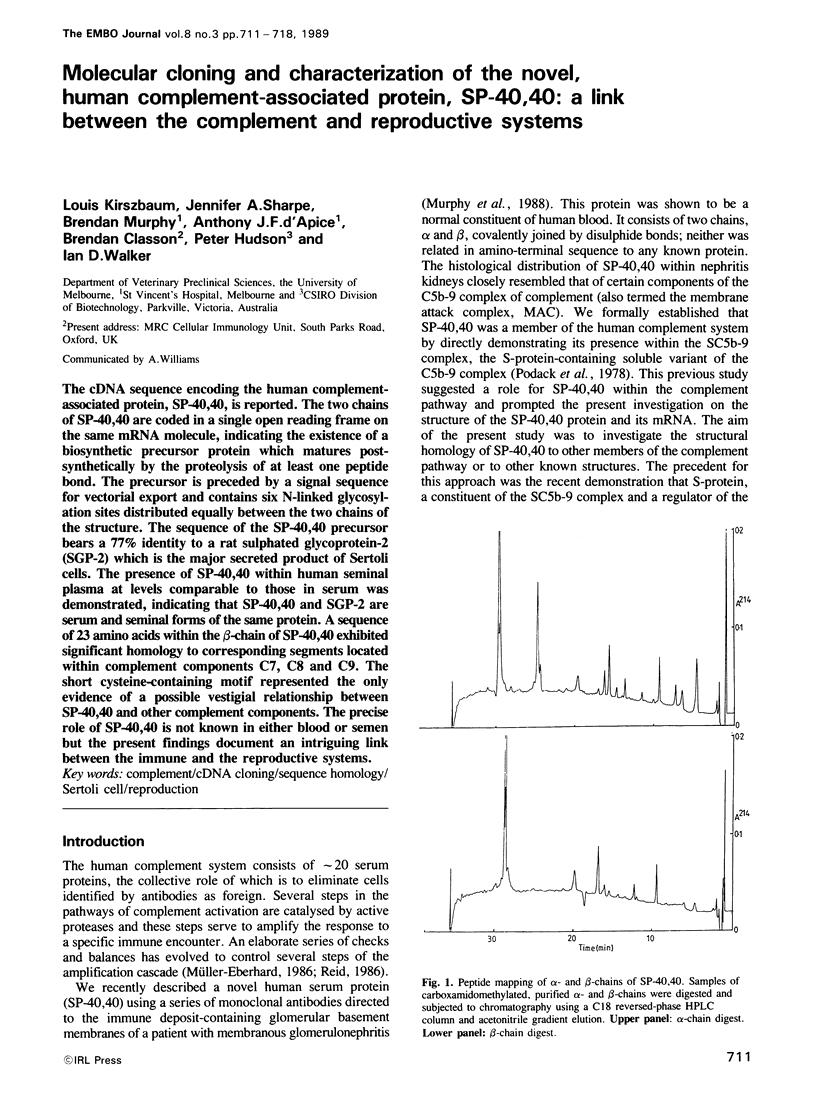
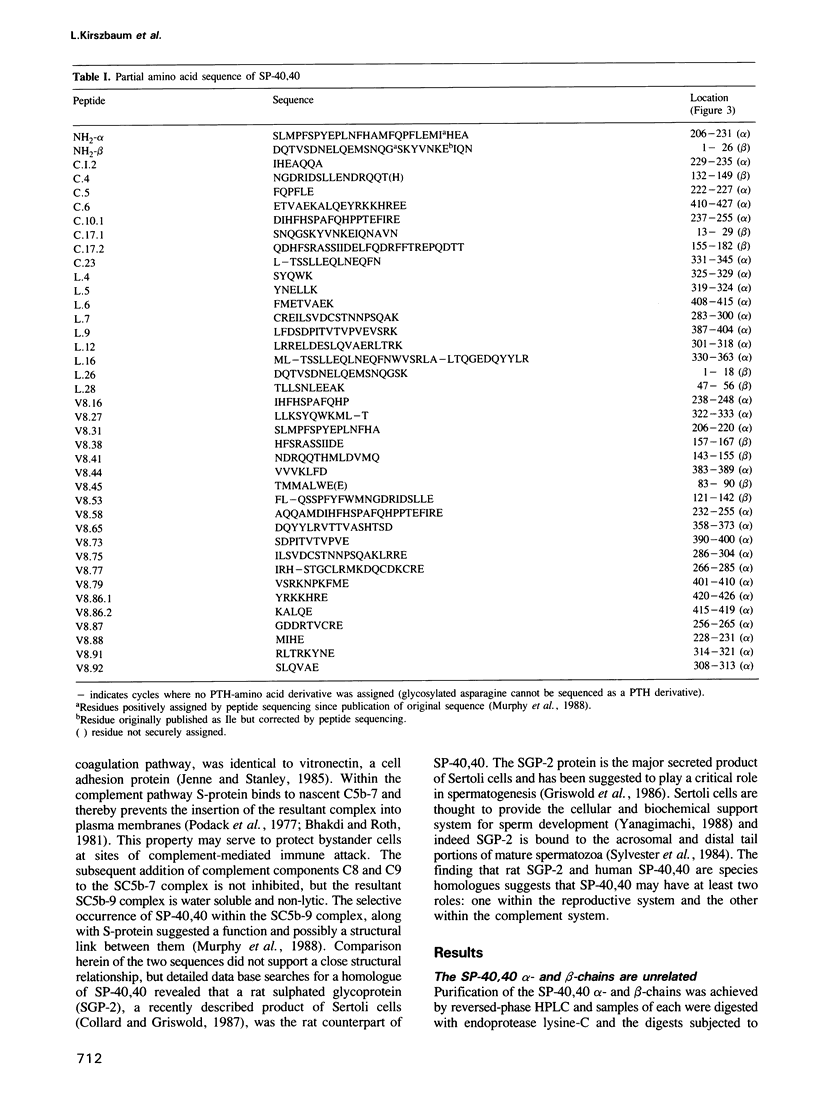
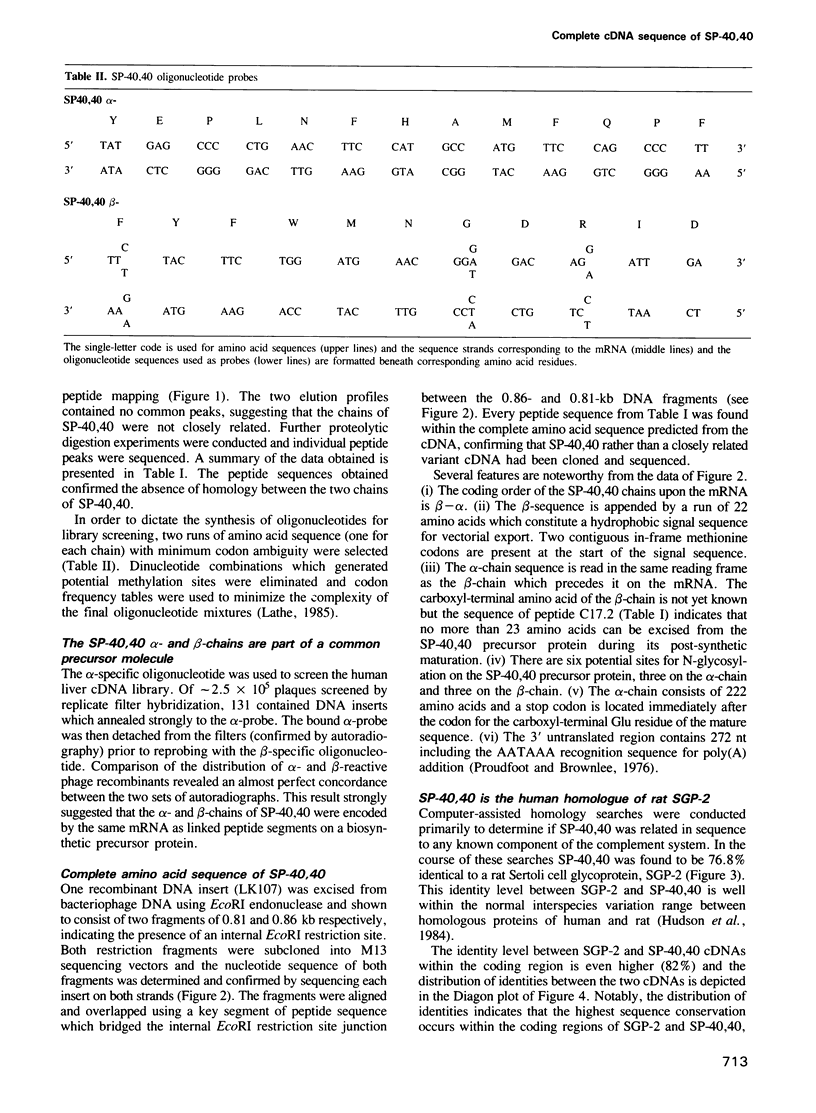
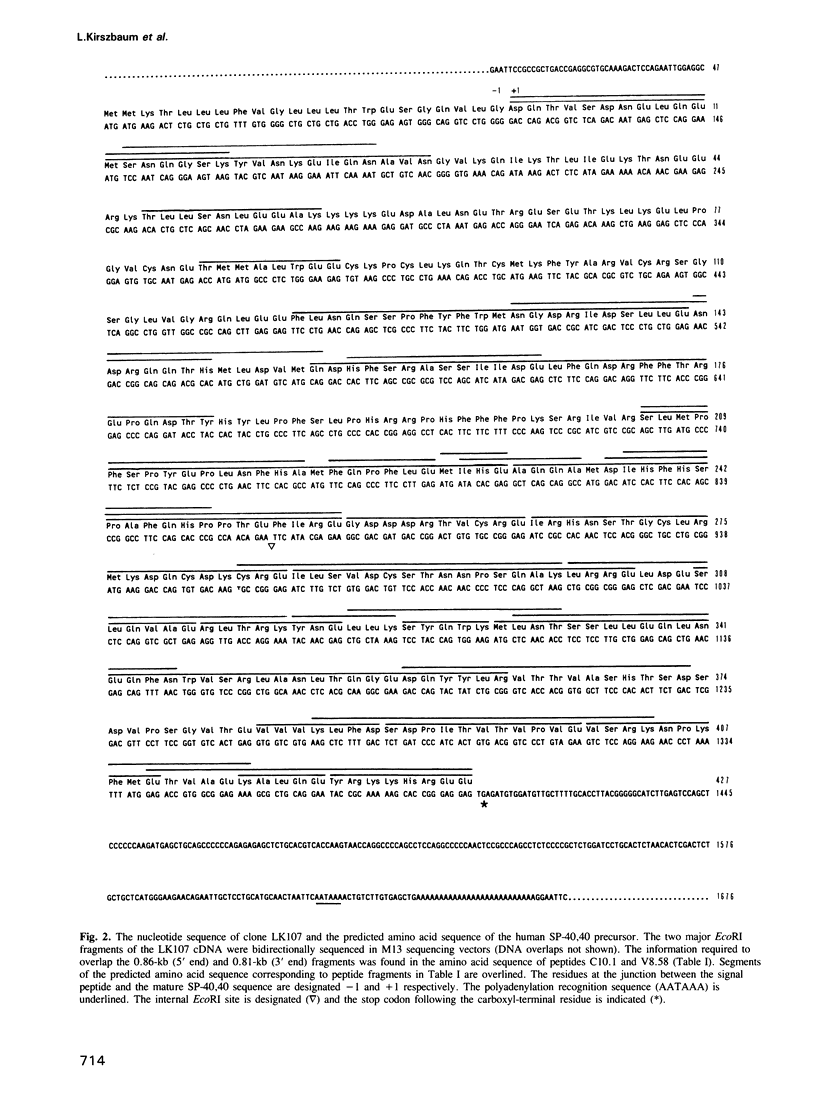
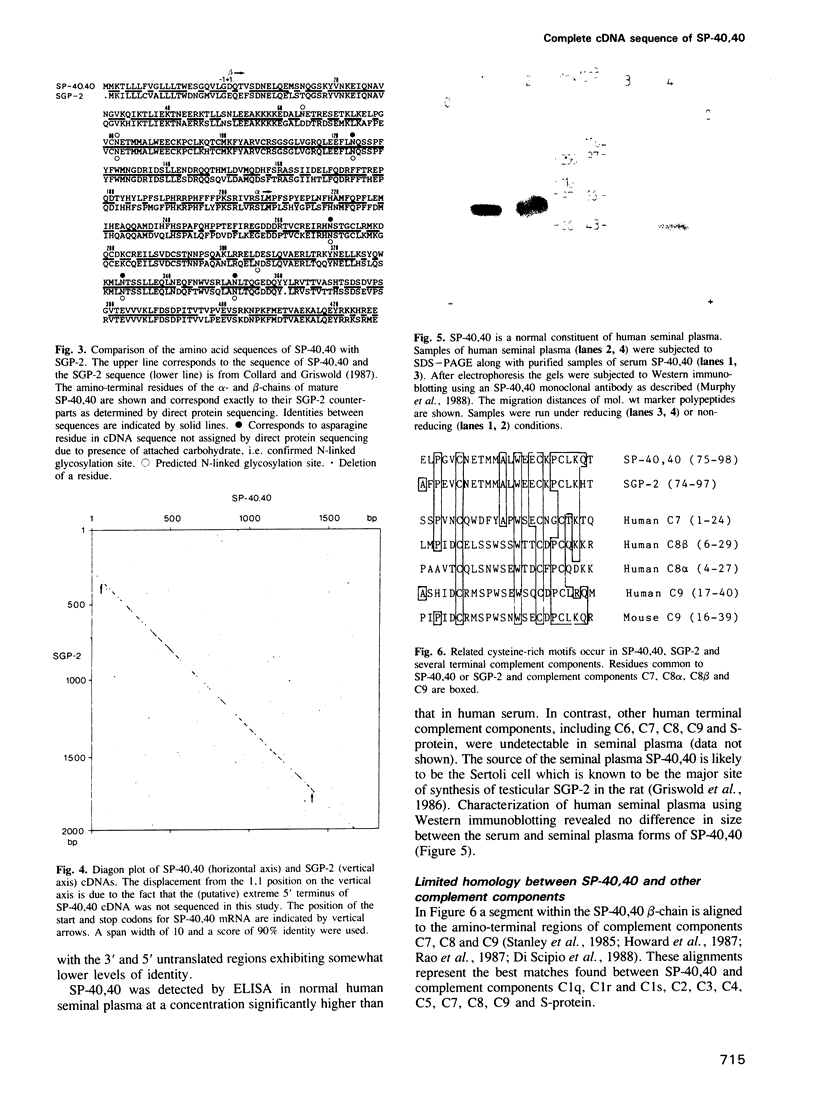
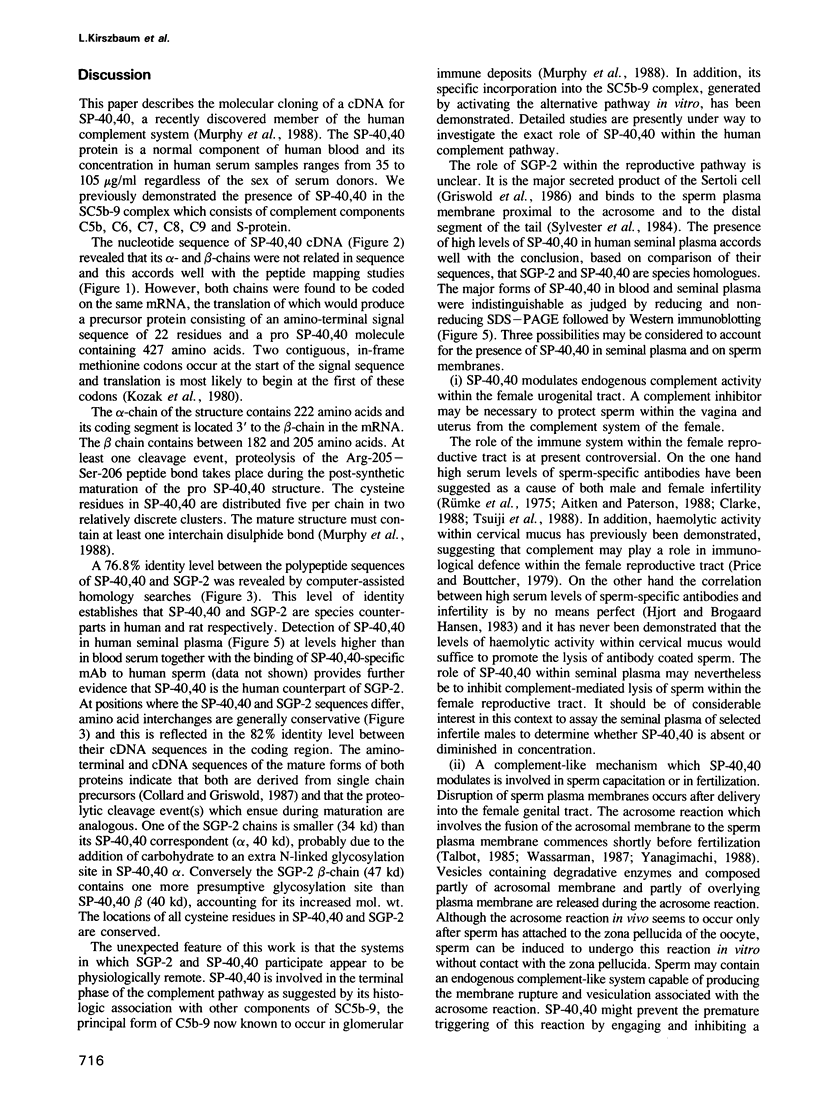
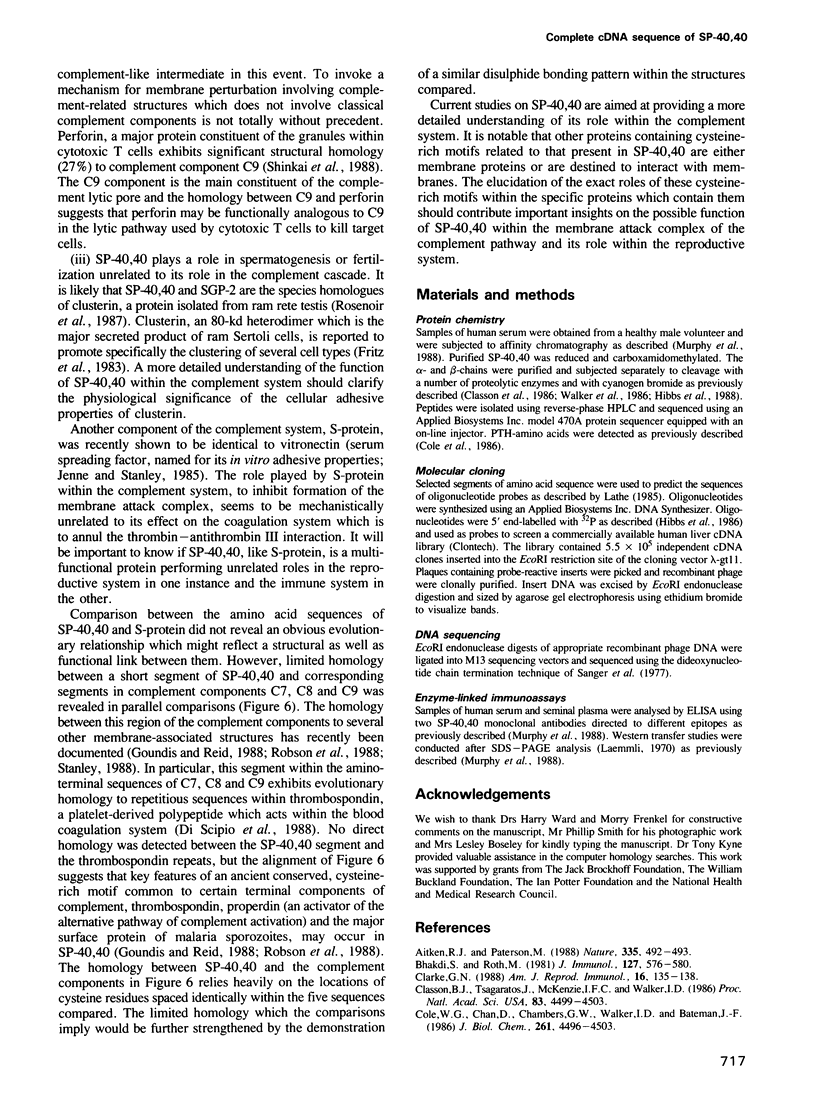
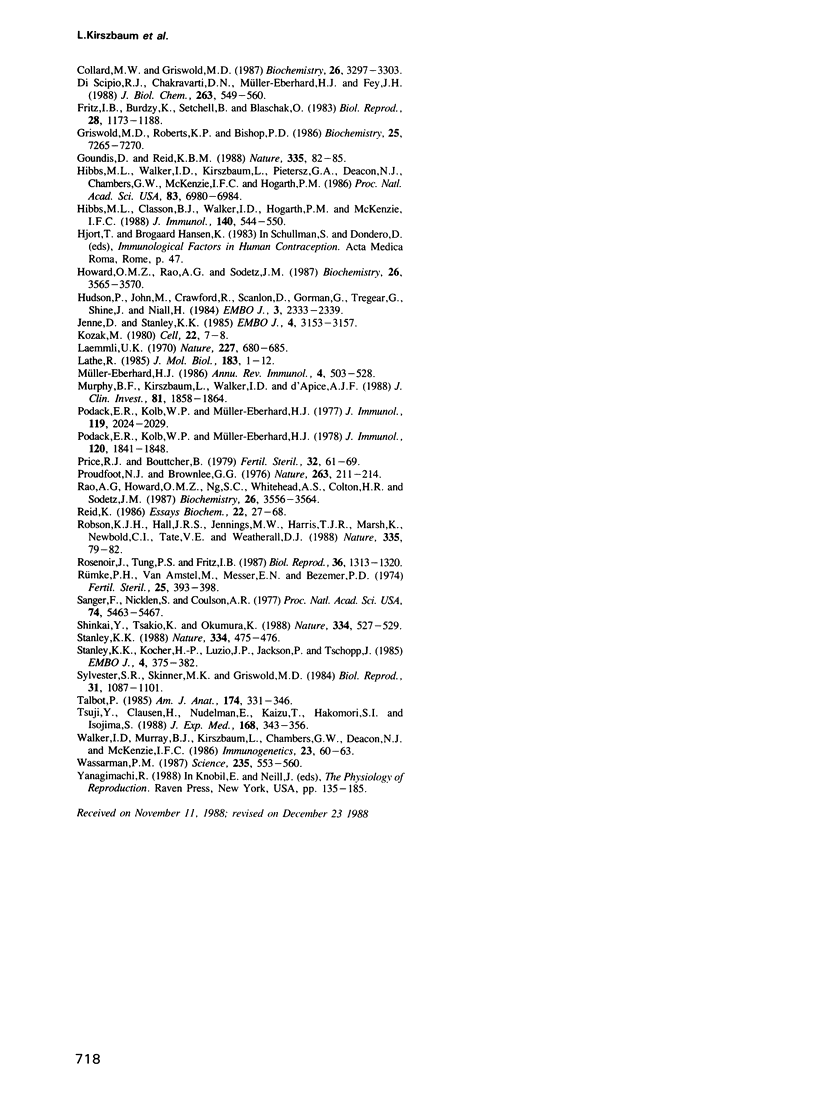
Images in this article
Selected References
These references are in PubMed. This may not be the complete list of references from this article.
- Aitken R. J., Paterson M. New horizons in contraception. Nature. 1988 Oct 6;335(6190):492–493. doi: 10.1038/335492a0. [DOI] [PubMed] [Google Scholar]
- Bhakdi S., Roth M. Fluid-phase SC5b-8 complex of human complement: generation and isolation from serum. J Immunol. 1981 Aug;127(2):576–580. [PubMed] [Google Scholar]
- Clarke G. N. Immunoglobulin class and regional specificity of antispermatozoal autoantibodies blocking cervical mucus penetration by human spermatozoa. Am J Reprod Immunol Microbiol. 1988 Apr;16(4):135–138. doi: 10.1111/j.1600-0897.1988.tb00183.x. [DOI] [PubMed] [Google Scholar]
- Classon B. J., Tsagaratos J., McKenzie I. F., Walker I. D. Partial primary structure of the T4 antigens of mouse and sheep: assignment of intrachain disulfide bonds. Proc Natl Acad Sci U S A. 1986 Jun;83(12):4499–4503. doi: 10.1073/pnas.83.12.4499. [DOI] [PMC free article] [PubMed] [Google Scholar]
- Collard M. W., Griswold M. D. Biosynthesis and molecular cloning of sulfated glycoprotein 2 secreted by rat Sertoli cells. Biochemistry. 1987 Jun 16;26(12):3297–3303. doi: 10.1021/bi00386a008. [DOI] [PubMed] [Google Scholar]
- DiScipio R. G., Chakravarti D. N., Muller-Eberhard H. J., Fey G. H. The structure of human complement component C7 and the C5b-7 complex. J Biol Chem. 1988 Jan 5;263(1):549–560. [PubMed] [Google Scholar]
- Fritz I. B., Burdzy K., Sétchell B., Blaschuk O. Ram rete testis fluid contains a protein (clusterin) which influences cell-cell interactions in vitro. Biol Reprod. 1983 Jun;28(5):1173–1188. doi: 10.1095/biolreprod28.5.1173. [DOI] [PubMed] [Google Scholar]
- Goundis D., Reid K. B. Properdin, the terminal complement components, thrombospondin and the circumsporozoite protein of malaria parasites contain similar sequence motifs. Nature. 1988 Sep 1;335(6185):82–85. doi: 10.1038/335082a0. [DOI] [PubMed] [Google Scholar]
- Griswold M. D., Roberts K., Bishop P. Purification and characterization of a sulfated glycoprotein secreted by Sertoli cells. Biochemistry. 1986 Nov 18;25(23):7265–7270. doi: 10.1021/bi00371a003. [DOI] [PubMed] [Google Scholar]
- Hibbs M. L., Classon B. J., Walker I. D., McKenzie I. F., Hogarth P. M. The structure of the murine Fc receptor for IgG. Assignment of intrachain disulfide bonds, identification of N-linked glycosylation sites, and evidence for a fourth form of Fc receptor. J Immunol. 1988 Jan 15;140(2):544–550. [PubMed] [Google Scholar]
- Hibbs M. L., Walker I. D., Kirszbaum L., Pietersz G. A., Deacon N. J., Chambers G. W., McKenzie I. F., Hogarth P. M. The murine Fc receptor for immunoglobulin: purification, partial amino acid sequence, and isolation of cDNA clones. Proc Natl Acad Sci U S A. 1986 Sep;83(18):6980–6984. doi: 10.1073/pnas.83.18.6980. [DOI] [PMC free article] [PubMed] [Google Scholar]
- Howard O. M., Rao A. G., Sodetz J. M. Complementary DNA and derived amino acid sequence of the beta subunit of human complement protein C8: identification of a close structural and ancestral relationship to the alpha subunit and C9. Biochemistry. 1987 Jun 16;26(12):3565–3570. doi: 10.1021/bi00386a047. [DOI] [PubMed] [Google Scholar]
- Hudson P., John M., Crawford R., Haralambidis J., Scanlon D., Gorman J., Tregear G., Shine J., Niall H. Relaxin gene expression in human ovaries and the predicted structure of a human preprorelaxin by analysis of cDNA clones. EMBO J. 1984 Oct;3(10):2333–2339. doi: 10.1002/j.1460-2075.1984.tb02135.x. [DOI] [PMC free article] [PubMed] [Google Scholar]
- Jenne D., Stanley K. K. Molecular cloning of S-protein, a link between complement, coagulation and cell-substrate adhesion. EMBO J. 1985 Dec 1;4(12):3153–3157. doi: 10.1002/j.1460-2075.1985.tb04058.x. [DOI] [PMC free article] [PubMed] [Google Scholar]
- Kozak M. Evaluation of the "scanning model" for initiation of protein synthesis in eucaryotes. Cell. 1980 Nov;22(1 Pt 1):7–8. doi: 10.1016/0092-8674(80)90148-8. [DOI] [PubMed] [Google Scholar]
- Laemmli U. K. Cleavage of structural proteins during the assembly of the head of bacteriophage T4. Nature. 1970 Aug 15;227(5259):680–685. doi: 10.1038/227680a0. [DOI] [PubMed] [Google Scholar]
- Lathe R. Synthetic oligonucleotide probes deduced from amino acid sequence data. Theoretical and practical considerations. J Mol Biol. 1985 May 5;183(1):1–12. doi: 10.1016/0022-2836(85)90276-1. [DOI] [PubMed] [Google Scholar]
- Murphy B. F., Kirszbaum L., Walker I. D., d'Apice A. J. SP-40,40, a newly identified normal human serum protein found in the SC5b-9 complex of complement and in the immune deposits in glomerulonephritis. J Clin Invest. 1988 Jun;81(6):1858–1864. doi: 10.1172/JCI113531. [DOI] [PMC free article] [PubMed] [Google Scholar]
- Müller-Eberhard H. J. The membrane attack complex of complement. Annu Rev Immunol. 1986;4:503–528. doi: 10.1146/annurev.iy.04.040186.002443. [DOI] [PubMed] [Google Scholar]
- Podack E. R., Kolb W. P., Müller-Eberhard H. J. The C5b-6 complex: formation, isolation, and inhibition of its activity by lipoprotein and the S-protein of human serum. J Immunol. 1978 Jun;120(6):1841–1848. [PubMed] [Google Scholar]
- Podack E. R., Kolb W. P., Müller-Eberhard H. J. The SC5b-7 complex: formation, isolation, properties, and subunit composition. J Immunol. 1977 Dec;119(6):2024–2029. [PubMed] [Google Scholar]
- Price R. J., Boettcher B. The presence of complement in human cervical mucus and its possible relevance to infertility in women with complement-dependent sperm-immobilizing antibodies. Fertil Steril. 1979 Jul;32(1):61–66. doi: 10.1016/s0015-0282(16)44117-8. [DOI] [PubMed] [Google Scholar]
- Proudfoot N. J., Brownlee G. G. 3' non-coding region sequences in eukaryotic messenger RNA. Nature. 1976 Sep 16;263(5574):211–214. doi: 10.1038/263211a0. [DOI] [PubMed] [Google Scholar]
- Rao A. G., Howard O. M., Ng S. C., Whitehead A. S., Colten H. R., Sodetz J. M. Complementary DNA and derived amino acid sequence of the alpha subunit of human complement protein C8: evidence for the existence of a separate alpha subunit messenger RNA. Biochemistry. 1987 Jun 16;26(12):3556–3564. doi: 10.1021/bi00386a046. [DOI] [PubMed] [Google Scholar]
- Reid K. B. Activation and control of the complement system. Essays Biochem. 1986;22:27–68. [PubMed] [Google Scholar]
- Robson K. J., Hall J. R., Jennings M. W., Harris T. J., Marsh K., Newbold C. I., Tate V. E., Weatherall D. J. A highly conserved amino-acid sequence in thrombospondin, properdin and in proteins from sporozoites and blood stages of a human malaria parasite. Nature. 1988 Sep 1;335(6185):79–82. doi: 10.1038/335079a0. [DOI] [PubMed] [Google Scholar]
- Rosenior J., Tung P. S., Fritz I. B. Biosynthesis and secretion of clusterin by ram rete testis cell-enriched preparations in culture. Biol Reprod. 1987 Jun;36(5):1313–1320. doi: 10.1095/biolreprod36.5.1313. [DOI] [PubMed] [Google Scholar]
- Rumke P., Van Amstel N., Messer E. N., Bezemer P. D. Prognosis of fertility of men with sperm agglutinins in the serum. Fertil Steril. 1974 May;25(5):393–398. doi: 10.1016/s0015-0282(16)40388-2. [DOI] [PubMed] [Google Scholar]
- Sanger F., Nicklen S., Coulson A. R. DNA sequencing with chain-terminating inhibitors. Proc Natl Acad Sci U S A. 1977 Dec;74(12):5463–5467. doi: 10.1073/pnas.74.12.5463. [DOI] [PMC free article] [PubMed] [Google Scholar]
- Shinkai Y., Takio K., Okumura K. Homology of perforin to the ninth component of complement (C9). Nature. 1988 Aug 11;334(6182):525–527. doi: 10.1038/334525a0. [DOI] [PubMed] [Google Scholar]
- Stanley K. K., Kocher H. P., Luzio J. P., Jackson P., Tschopp J. The sequence and topology of human complement component C9. EMBO J. 1985 Feb;4(2):375–382. doi: 10.1002/j.1460-2075.1985.tb03639.x. [DOI] [PMC free article] [PubMed] [Google Scholar]
- Stanley K., Luzio P. Perforin. A family of killer proteins. Nature. 1988 Aug 11;334(6182):475–476. doi: 10.1038/334475a0. [DOI] [PubMed] [Google Scholar]
- Sylvester S. R., Skinner M. K., Griswold M. D. A sulfated glycoprotein synthesized by Sertoli cells and by epididymal cells is a component of the sperm membrane. Biol Reprod. 1984 Dec;31(5):1087–1101. doi: 10.1095/biolreprod31.5.1087. [DOI] [PubMed] [Google Scholar]
- Talbot P. Sperm penetration through oocyte investments in mammals. Am J Anat. 1985 Nov;174(3):331–346. doi: 10.1002/aja.1001740312. [DOI] [PubMed] [Google Scholar]
- Tsuji Y., Clausen H., Nudelman E., Kaizu T., Hakomori S., Isojima S. Human sperm carbohydrate antigens defined by an antisperm human monoclonal antibody derived from an infertile woman bearing antisperm antibodies in her serum. J Exp Med. 1988 Jul 1;168(1):343–356. doi: 10.1084/jem.168.1.343. [DOI] [PMC free article] [PubMed] [Google Scholar]
- Walker I. D., Murray B. J., Kirszbaum L., Chambers G. W., Deacon N. J., McKenzie I. F. The amino-terminal sequences of Ly-2 and Ly-3. Immunogenetics. 1986;23(1):60–63. doi: 10.1007/BF00376523. [DOI] [PubMed] [Google Scholar]
- Wassarman P. M. The biology and chemistry of fertilization. Science. 1987 Jan 30;235(4788):553–560. doi: 10.1126/science.3027891. [DOI] [PubMed] [Google Scholar]



